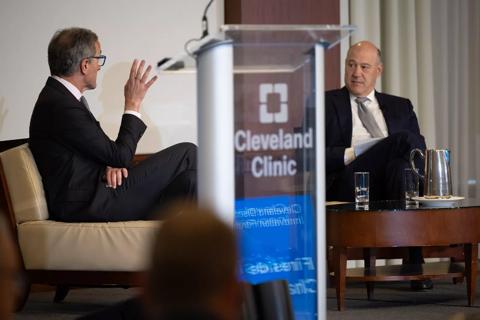Taking a hybrid approach

Some of the world’s largest companies have made headlines by eliminating performance ratings, opting instead for “continuous” reviews of employees’ work. But is ditching the rating system a good idea? Joe Rak, Cleveland Clinic’s Director of Talent Management in the Global Leadership and Learning Institute, shares his thoughts.
Advertisement
Cleveland Clinic is a non-profit academic medical center. Advertising on our site helps support our mission. We do not endorse non-Cleveland Clinic products or services. Policy
A: In the traditional model of annual performance reviews, you’re graded at the end of the year. It’s reflective. It looks back, and the manager says, here’s what you did right, here’s what you did wrong, here’s the grade I’m going to give you. With continuous, the reflective look-back goes away. Instead, I’m going to meet with you quarterly or monthly, or even weekly, and say, how’s it going? How can I support you? What are your goals? No rating. Next week, hey how are you doing? How are you doing on your goals? They say you continuously nurture, and you have more frequent feedback, a better discussion and higher engagement.
A: We are implementing elements of continuous review, but not the full model as others are doing. One, it’s not proven yet, and the early signs don’t necessarily look good for eliminating formal performance reviews and ratings altogether. They’ve found managers tend to use what some have called a shadow rating system — they do it on the back of the envelope, informally, for their own sets of rules. It’s human nature to compare and make sure that people are adequately positioned for the job, and we would rather it be transparent and well understood throughout the organization about what the standards for success look like.
There’s also another side to it — especially in healthcare — of high accountability for the gravity of the work we do. I mean, imagine your mother is going in for heart surgery and you asked, “Is everybody held accountable and responsible for their job and meeting their qualifications?” And I said, “Well no, there’s no formal grading, but their managers check in with them often.” You can see how that might not inspire a lot of confidence, and it would introduce variability from manager to manager. At the end of the day, the standards for performance should be formalized.
Advertisement
A: I don’t think that APRs are at odds with the benefits of continuous reviews, so we’re doing a hybrid approach. In 2017, we introduced education for managers in performance coaching. How to have good, meaningful performance discussions with your employees, with your caregivers — future-facing, proactive conversations — to say ‘how can I help you reach your goals,’ and to check in at regular intervals. Honestly, it’s just good management to be able to do that.
In addition, we’ve enabled in our electronic HR systems the ability for managers to solicit feedback from anybody at any time. So the manager is well-equipped to get continuous feedback throughout the year. One more tool we’re introducing this year is what we call check-ins. We’re expecting people to check in at least once throughout the year, almost like a mid-year review. And we’re encouraging managers to check in more frequently — monthly or quarterly. It’s very brief, very easy, and oriented around very specific goals. It’s also future-oriented, with a focus on supporting the employee in achieving their goals, rather than grading past performance.
All of that rolls to the end of the year, when they’re evaluated on common standards, assessed and given a rating that, by the way, should not be a surprise to the person. But that’s the reflective look back that really sets the standard of, are they where they need to be for the organization?
A: First, test it on a small scale over a period of time, like a couple of years. I know that might seem like a lot, but the jury’s still out on eliminating annual reviews and performance ratings altogether. Do some research and read up on the studies. Even though it looks great on paper, it’s not fully proven in industry.
Advertisement
Second, I would say that you can have the best of both worlds. You can look at your existing system, skinny that down and keep the value-added parts, and introduce the best parts of this continuous system. It’s all well and good to say, “I want to coach each person based on where they’re at,” but at the end of the day, especially for healthcare, we do have to have standards. We have to require that people perform at a certain level, because lives are on the line.
Learn about Cleveland Clinic’s transformational leadership development programs, available through Global Executive Education.
Advertisement
Advertisement

Advanced software streamlines charting, supports deeper patient connections

How holding simulations in clinical settings can improve workflow and identify latent operational threats

Interactive Zen Quest experience helps promote relaxing behaviors

Cleveland Clinic and IBM leaders share insights, concerns, optimism about impacts

Cleveland Clinic partners with Palantir to create logistical command center

A Q&A with organizational development researcher Gina Thoebes

Cleveland Clinic transformation leader led development of benchmarking tool with NAHQ

Raed Dweik, MD, on change management and the importance of communication